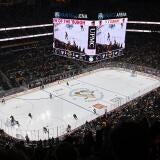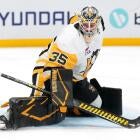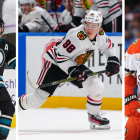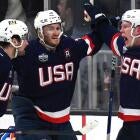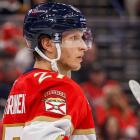NHL offseason grades: Sabres get an A, Bruins just average
The Eye On Hockey staff looks at the progress made by every team in the NHL this offseason on a division-by-division basis. On Monday, we start with the Easter Conference's Atlantic Division.

Over the next week the Eye On Hockey staff will be taking a look at the progress that has been made by every team in the NHL this offseason on a division-by-division basis. We'll also examine the best and worst moves made throughout each division, as well as the teams taht did the most (and least) to improve.
On Monday, we start off by looking at the Eastern Conference's Atlantic Division where several teams went through some significant changes this offseason. It's been a pretty busy offseason in the division so far, with the biggest changes coming in Boston, Toronto, Detroit and Buffalo.
Mike Babcock, after 10 years behind the Red Wings' bench, now gets the task of trying to turn the Maple Leafs into a winner along with Brendan Shanahan and Lou Lamoriello, while Jeff Blashill replaces him in Detroit and looks to carry on their winning tradition. The Bruins, after missing the playoffs in 2014-15, were one of the busiest teams this summer and should be one of the most intriguing teams in the league entering the 2015-16 season, while the Buffalo Sabres made enough moves to go from the worst team in the league to one that should at least be pretty competitive.
Obviously some teams can still change their look over the next couple of months with trades, but we're simply looking to see just how much each team has -- has not -- improved through the first two months of the offseason. So let's get started.
| Team | Grades | Analysis |
|---|---|---|
 |
C | Bruins analysis: Missing the playoffs in 2014-15 led to a complete overhaul in Boston from the front office all the way down to the ice. Don Sweeney replaced Peter Chiarelli as the team's general manager and used his first summer running the show to make some sweeping changes to the roster. Gone are Milan Lucic, Dougie Hamilton, Carl Soderberg, Reilly Smith and Gregory Campbell. In are a bunch of draft picks and prospects, Matt Beleskey, and Jimmy Hayes. On one hand, the Lucic trade was probably great value to turn the final year of his contract into a prospect and two first-round draft picks. They also managed to get out from under the remainder of Marc Savard's contract and sign Beleskey for less than anticipated prior to the start of the summer. But losing Hamilton (and even Soderberg) with nothing really coming back the other way to help in the immediate future is a significant blow. Some good. Some bad. And a team that is a pretty big mystery going into the season. |
 |
A | Sabres analysis: If they did nothing else this offseason the Jack Eichel pick alone would have been a significant move for the Sabres franchise. But they didn't stop there, mostly because they knew Eichel alone, even if he turns out to be every bit as good as he is expected to be, wouldn't be enough to turn this thing around. So they went out and picked up a starting goalie (Robin Lehner), traded for one of the best two-way centers in the league (Ryan O'Reilly) and also have Evander Kane joining the team after the pre-deadline deal during the season. Given the cost of goalies around the league they probably paid too steep of a price for Lehner (a first-round pick, while also taking back the remaining year of David Legwand's contract) but after starting with three first-round draft picks in 2015, including the No. 2 overall pick in the draft, it's a gamble they could afford to take. |
 |
B | Red Wings analysis: The biggest change in Detroit this offseason is the one behind the bench where Jeff Blashill takes over the spot that Mike Babcock occupied for a decade. The Red Wings' style of play probably won't change much, but it's going to be interesting to see if the younger player on the rosters are able to get a longer leash than they did under Babcock. Blashill has coached -- and won -- with many of them in the AHL. Gustav Nyquist's contract should prove to be a steal for the Red Wings over the next couple of years, while Mike Green gives the team the puck-moving, right handed shot it has badly needed on its defense. Brad Richards should also add some nice depth down the middle, provided they don't count on him to do too much. |
 |
C+ | Panthers analysis: It's been a relatively quiet offseason for the Panthers whose biggest moves were re-signing Jaromir Jagr (who seemed to be a perfect fit on a line with Aleksander Barkov and Jonathan Huberdeau) and trading Jimmy Hayes to Boston for Reilly Smith and the remainder of Marc Savard's contract. With Huberdeau, Barkov, Nick Bjugstad and Aaron Ekblad this is a team that should be on the rise this season, especially if the veterans on the team like Roberto Luongo and Brian Campbell can continue to be impact players. Their willingness to take on Savard's contract remains a bit of a mystery because it's not as if they're a team that was in need of a contract to reach the cap floor. They are well above it, and actually have quite a few big contracts already on the roster and will need to give a lot of young players raises in the summer of 2016 when Savard still counts for more than $4 million against the cap. |
 |
B | Canadiens analysis: The Canadiens made the ultimate boom-or-bust signing when they picked up Alexander Semin for one year in late July. If it works, they're going to be one of the most skilled players in the league with something to prove and get one heck of a productive player. Worst case scenario? Semin continues his struggles from a year ago in Carolina, doesn't fit in with Michel Therrien and the Canadiens part ways after the season and only lose $1.1 million. The Canadiens also re-signed Jeff Petry to a long-term deal after a successful run with the team after the trade deadline and traded Brandon Prust for Zack Kassian. Kassian hasn't really panned out as expected with Buffalo and Vancouver, but he is still five years younger than Prust, was more productive last season and still has more potential to improve. |
 |
B | Senators analysis: When it comes to adding players the Senators really haven't been very active, but they did manage to re-sign a couple of their younger players Mika Zibanejad and Mark Stone to team-friendly contracts and took advantage of their goaltender surplus by picking up an additional first-round draft pick for Robin Lehner, while also using that trade as a means of dumping David Legwand's contract. |
 |
B | Lightning analysis: The No. 1 priority for the Tampa Bay Lightning this offseason was to simply try and work out a new deal with Steven Stamkos who is currently entering the final year of his contract. There doesn't seem to be any hurry when it comes to serious talks at this point, but they have until next summer to work out. It's really not the type of thing you want hanging over your team during the season, but both sides seem committed to getting it taken care of. In the meantime, the Lightning have most of their impressive core locked up for several years and didn't really need to make any major moves after their trip to the Stanley Cup Final. The one move they did make was bringing in free agent forward Erik Condra from division-rival Ottawa. Condra won't provide a ton of offense, but he is an excellent defensive forward and penalty killer that should be a great addition to an already deep lineup for a very good price. |
 |
C | Maple Leafs analysis: Like Boston, there is a lot to like and a lot to not like about what Toronto has done this offseason. Getting perhaps the best coach in the NHL in Mike Babcock is a major move, and the team did make a bunch of smart, under-the-radar free agent signings that can give the team some nice production this season and be flipped at the deadline for more future assets (like draft picks). They likely won't see any kind of a return on those investments for several years, but it's not a bad strategy, especially after a similar approach helped them restock their prospect cupboard this past year. But the biggest move the Maple Leafs made this offseason was probably their worst one when it came to trading Phil Kessel to the Pittsburgh Penguins, taking on a significant chunk of his contract, and not getting one of Pittsburgh's top young defensemen (Derrick Pouliot or Olli Maatta) as part of the deal. Forward Kasperi Kapanen is a fine prospect, but Scott Harrington and Nick Spaling as the remaining key pieces of that deal (there was also a swap of conditional draft picks in there) is pretty underwhelming for one of the best goal scorers in the league that is still only 27 years old and still has years of term left on his contract. The addition of Lou Lamoriello to the front office was also a pretty shocking move. Not only because it came out of nowhere, but also because it's not yet clear how much influence he will have on the decision-making process. And if his past few years in New Jersey are any indication, it would probably be best if he wasn't the one driving the discussion. |
Best Move: Red Wings sign Mike Green
A lot of people won't like this one because Mike Green is the type of defenseman that a lot of hockey folks tend to loathe.
Because of his style of play and point production he is often times viewed as more of a fourth forward on the ice instead of a defenseman, and he is not going to play an overly physical or "heavy" game in the defensive zone.
But he is still a perfect fit for the Red Wings and their style of play. He moves the puck well up the ice and minimizes the amount of time he has to spend in the defensive zone (where his flaws would be more exposed) and is still one of the best power play quarterbacks in the NHL. He also signed a pretty fair contract in free agency, landing in Detroit for $18 million over three years. When compared to what some other defensemen have signed for in free agency over the years that is not a bad investment for the Red Wings. The cap hit is competitive for a player like Green, and it's not an excessive number of years.
He will get caught out of position at times because of his aggressiveness with the puck, but that style play tends to end up working out in his -- and his team's -- favor more often than not.
Worst Move: Bruins trade Dougie Hamilton to Calgary Flames
Given his status as a restricted free agent and the Bruins' salary cap situation there was a very real chance that Hamilton was going to be playing for somebody other than Boston next season. The threat of an offer sheet was very real, and with the team unable to come to terms on a new contract they sent him to the Calgary Flames for three draft picks in 2015 (No. 15, 45 and 52).
When you consider that Boston was able to turn one year of a 27-year-old Milan Lucic into a prospect and what would become two first-round picks (Martin Jones, acquired as part of the Lucic trade with Los Angeles along with a first-round pick and prospect Colin Miller, was traded to San Jose for another first-round pick) it is a pretty underwhelming return for a 22-year-old that is probably already a top-pairing defenseman in the league and is only likely to keep getting better. Especially when the Bruins' defense as a whole is no longer a strength. With Hamilton and Johnny Boychuk gone, and Zdeno Chara and Dennis Seidenberg really starting to show their age at times over the past year goal prevention could be a serious issue for the Bruins this season. Hamilton was supposed to be the future of the position.
Tuukka Rask is going to have to really be on top of his game this season in Boston.
Most Improved team: Buffalo Sabres
Are they going to be a playoff team in 2015-16? Probably not. No. They would need an almost unheard of turnaround to go from worst team in recent NHL history to the postseason in one offseason, but that doesn't mean the team won't be capable of taking a huge step forward this season. The roster on paper is significantly better than the one that was getting crushed every night this past season, and even though they missed out on landing Mike Babcock to coach the team, they still ended up with a Stanley Cup winning coach -- and one that has probably been under appreciated in recent years for just how successful he has been in the NHL -- in Dan Bylsma. They solidified their goaltending with Lehner, and they actually have an NHL caliber group of forwards led by Eichel, Kane, O'Reilly, Matt Moulson, Brian Gionta and 2014 No. 2 overall pick Sam Reinhart.
Least improved team: Toronto Maple Leafs
Boston might have been a contender for this title, but they still have Patrice Bergeron, David Krejci, Tuukka Rask and Zdeno Chara. They may not be better, and they seem to be stuck in the no-man's land between contender and rebuilding team, but they still have enough high-end players on the roster that they should be able to at least compete. Toronto, on the other hand, was already a bad team, traded its best player, and didn't really add anybody to the NHL roster that is going to make a significant impact this season.
There is actually a lot to like about the Maple Leafs' long-term prospects as Brendan Shanahan and the front office seem to have a pretty clear plan in place when it comes to collecting draft picks and building prospect depth, while they also have a nice group of prospects led by Morgan Reilly, William Nylander and recent additions Mitch Marner and Kapanen. But this year's team is going to be rough once again. Their bargain bin free agent signings are fine for what they are, and should provide the office with some nice pieces to work with at the trade deadline, but they're not pieces that are going to get the Maple Leafs back into playoff contention this year.





